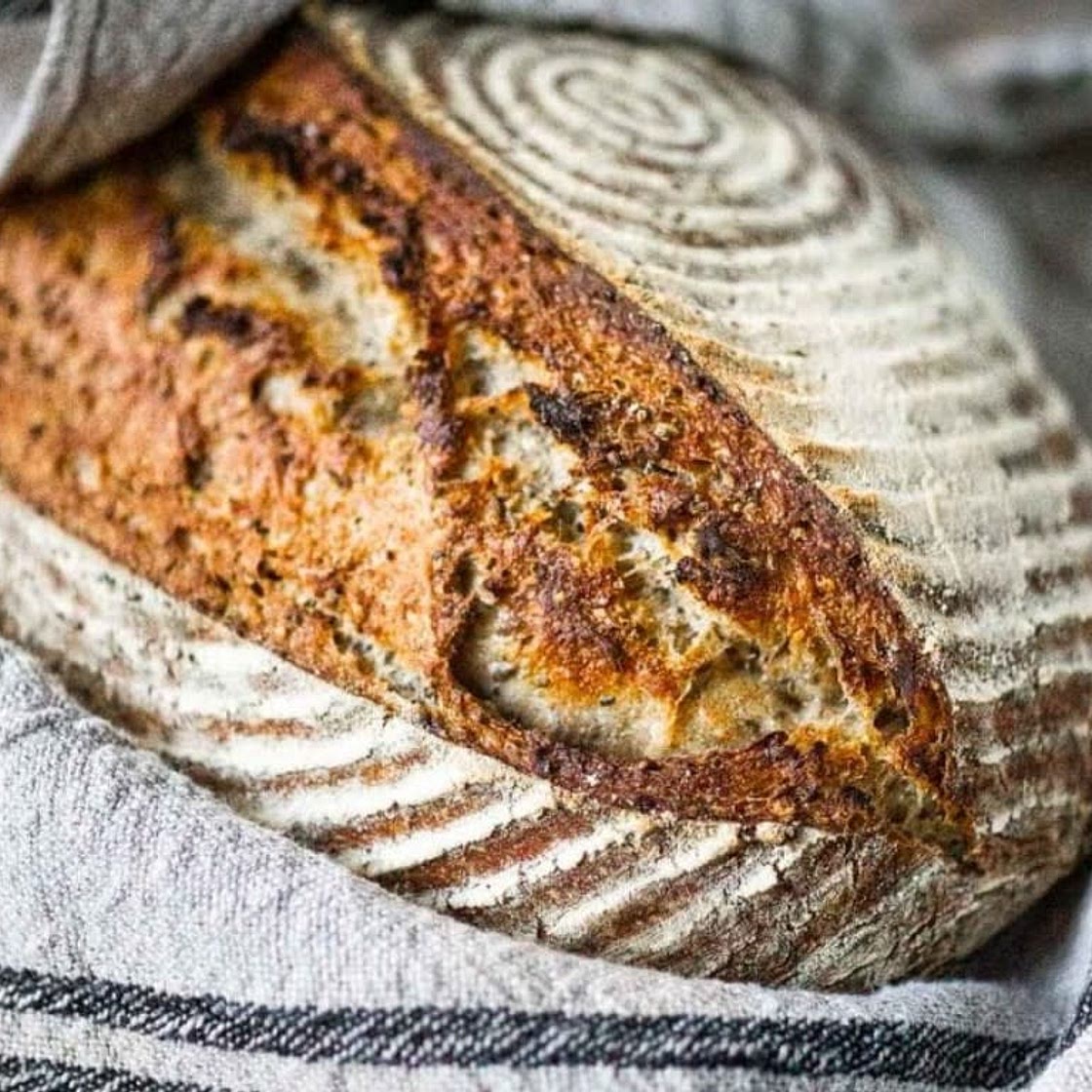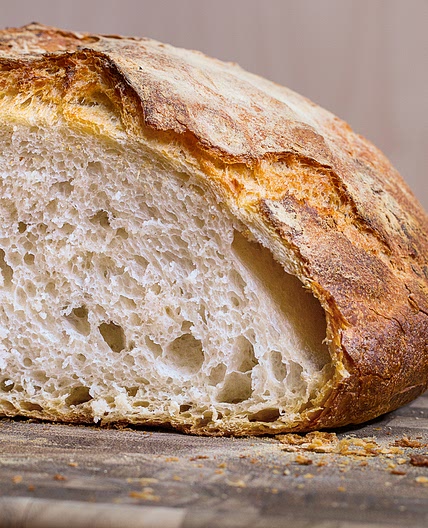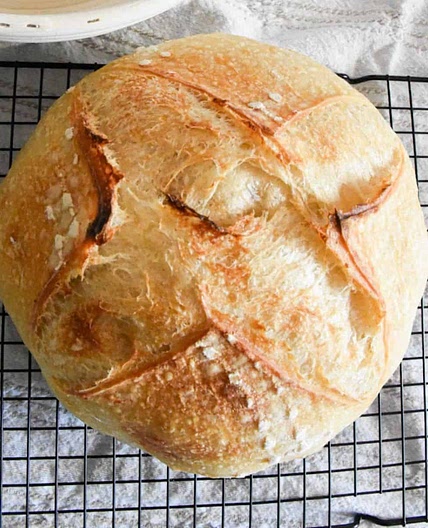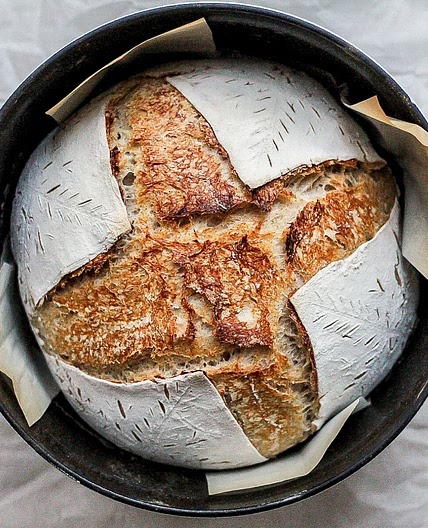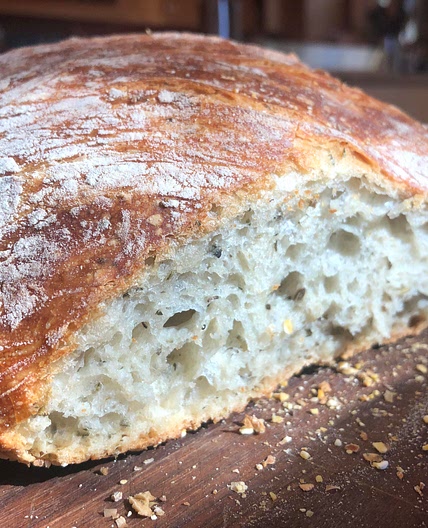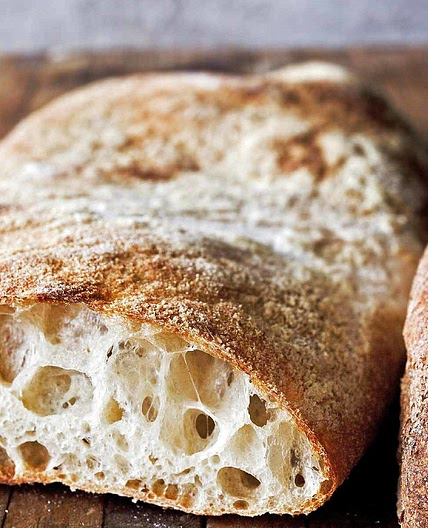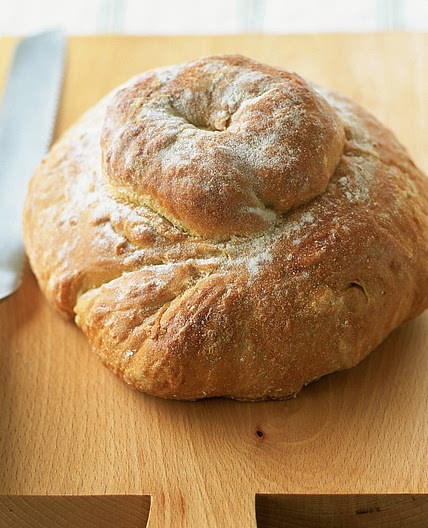Nutrition balance score
Good
Glycemic Index
72
High
Glycemic Load
34
High
Nutrition per serving
Calories234.2 kcal (12%)
Total Fat1.3 g (2%)
Carbs46.3 g (18%)
Sugars0.3 g (0%)
Protein7.9 g (16%)
Sodium466.3 mg (23%)
Fiber3.2 g (11%)
% Daily Values based on a 2,000 calorie diet
Ingredients
10 servings
Optional add ons
Instructions
Step 1
Schedule: raise the starter in the morning, bake in the evening. Proof overnight. Then bake in the morning
Step 2
Twelve hours before mixing your dough, feed your sourdough starter, leaving it out on the counter making sure it doubles in size within 6 hours.
Step 3
Weigh the flour in a medium bowl. Then add salt, spices, seeds. Mix starter and water in a small bowl until cloudy and well mixed. Pour the starter-water into flour incorporating all the flour using a fork or wood spoon. It should be a thick, shaggy, heavy, sticky dough. See video. Mix for about 1-2 minutes using the wood spoon- it will be hard to mix. Don’t worry about tidy dough here, just get the flour all mixed in and cover with a wet kitchen towel and let rest 15 minutes.
Step 4
Do the first set of stretches and folds. With one wet hand (put a bowl of water next to you) pull the dough from one side and stretch it upward, then fold it up and over to the center of the dough. Quarter turn the bowl and repeat, stretching up and folding it over the middle, repeat for about 30 seconds or until the dough gets firm and resists. This helps strengthen the gluten.
Step 5
Cover, rest, and repeat the process 15 minutes later. With wet fingers, stretch up and fold over, turning, repeating, for 30 seconds until the dough gets firm and resists. Then turn the dough over in the bowl. Yes, you could do this a couple more times if you would like to build the gluten, but not imperative.
Step 6
Proof overnight, at room temp. Cover the bowl with plastic wrap, wax wrap, or a damp kitchen towel (to keep the moisture in) and place it on your kitchen counter for 8-12 hours.
Step 7
Check the dough in the morning. The dough should have expanded, with a slight springy dome to the top. It won’t necessarily double in size ( maybe 1.5 -1.75 times bigger) but will have expanded. Do the POKE TEST: With a floured finger, poke into the dough. If it indents easily and mostly springs back to its original shape, it has probably risen enough. If it feels firm or very hard to indent, let it rise longer. If it feels loose, runny, or indents too easily or doesn’t spring back, it is most likely over-proofed (bake it anyways)
Step 8
Flour the banner on with rice flour. Then do the 2nd stretch and shape. Loosen the dough from the all edges of a bowl with using your wet fingers, a wet spatula or wet plastic dough scraper, sliding down the sides of the bowl. With both wet hands, carefully pull the dough straight up, in the middle and lift it, stretching straight up in the air- about 1-2 feet (see photo) and place it back down, gently folding it on top of itself. In this first stretch, the dough may feel quite loose and runny. This is OK. It should firm up as it stretches and folds. After the first stretch, give the bowl a quarter turn, wait 30-60 seconds, wet your hands again and stretch it up high again, folding over itself in the bowl. Wait 30-60 seconds. (You could repeat this one more time, 15 minutes later). Then, the third time you lift and stretch, you will lift it all the way into your floured banneton, folding over itself like you’ve been doing.
Step 9
FINAL RISE and PREHEAT OVEN: Place the bowl in the refrigerator for one hour uncovered which will firm up the bread, and make scoring easier and help boost “oven spring”. It won’t rise in the fridge. Preheat the oven (for 1 FULL hour) to 230°C with your dutch oven inside and lid on. SCORE & BAKE When ready to bake, place dough by the stove. Pull out the dutch oven, close the oven, remove lid. Score the bread in the bowl, using a very sharp knife, lame, razor blade, (or try scissors dipped in cold water), score the dough swiftly and deeply, at a 45-degree angle, 3/4- 1-inch deep. One deep slash is just fine. Or criss-cross, or crescent shape. (Or feel free to add other designs, for ideas -google “scoring bread”). You want to score where you want the dough to puff out from. You can also cut with wet kitchen scissors. Carefully lift the parchment by the corners and place both bread and parchment directly into the dutch oven. Cover quickly. It is OK if parchment peaks out. You want to score and transfer as quickly as possible. (Alternately, if using a proofing basket, cover the basket with parchment, carefully flip the dough into the parchment in the palm of your hand and then center the parchment and dough into your dutch oven, then score)
Step 10
BAKE. Place dutch oven in the middle of the 250°C oven for 20 mins. Lower heat to 220°C, continue baking 10-15 minutes until deeply golden.
Step 11
COOL: It will smell heavenly. Remove from the dutch oven, let it cool 1 hour on a rack or tilted up on its side, before slicing so you don’t let the steam out and don’t smash it- be patient.
Notes
1 liked
0 disliked
Delicious
Go-to
Makes leftovers
